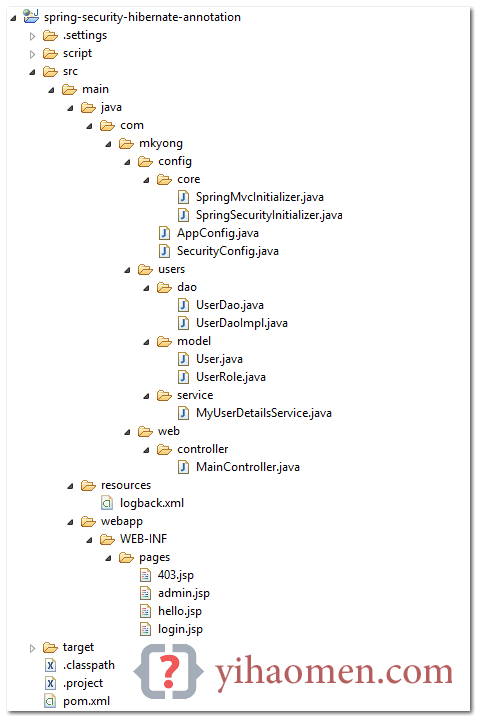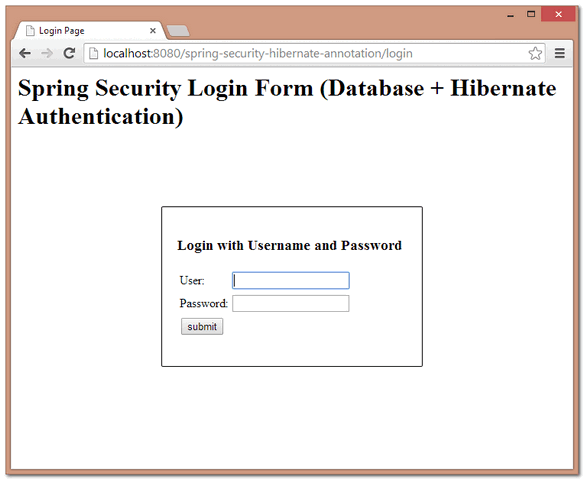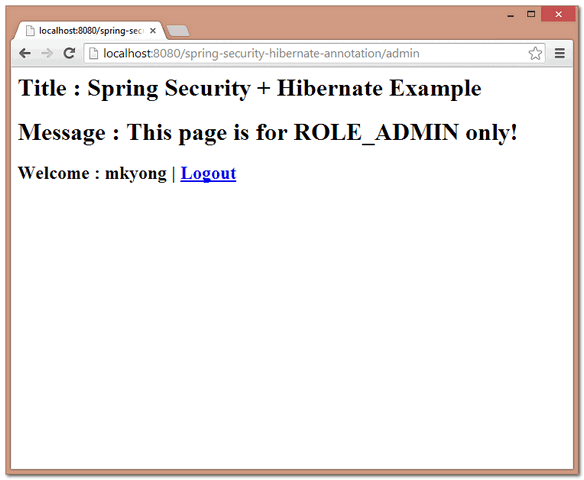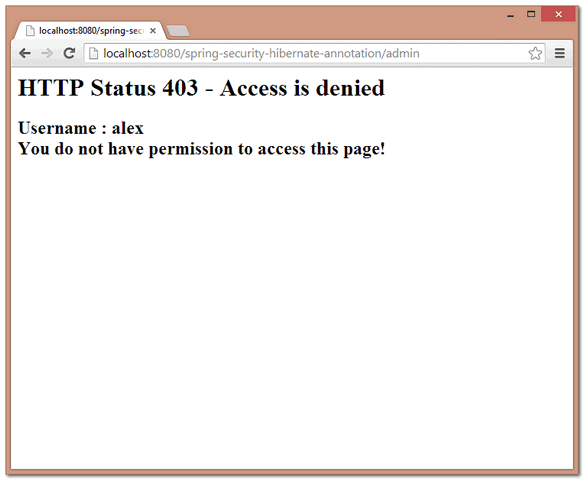Spring Security + Hibernate Annotation Example

In this tutorial, previous Spring Security + Hibernate4 XML example will be reused, and convert it to a annotation-based example.
Technologies used :
Spring 3.2.8.RELEASE
Spring Security 3.2.3.RELEASE
Hibernate 4.2.11.Final
MySQL Server 5.6
Tomcat 7 (Servlet 3.x container)
Quick Note :
Create a session factory with LocalSessionFactoryBuilder
Inject session factory into a UserDao
Integrate UserDao into a custom UserDetailsService, to load users from the database.
1. Project Directory
A final project directory structure.

2. User Model + Mapping File
Model classes and its’ annotation-based mapping file.
User.java
package com.mkyong.users.model;
import java.util.HashSet;
import java.util.Set;
import javax.persistence.Column;
import javax.persistence.Entity;
import javax.persistence.FetchType;
import javax.persistence.Id;
import javax.persistence.OneToMany;
import javax.persistence.Table;
@Entity
@Table(name = "users", catalog = "test")
public class User {
private String username;
private String password;
private boolean enabled;
private Set<UserRole> userRole = new HashSet<UserRole>(0);
public User() {
public User(String username, String password, boolean enabled) {
this.username = username;
this.password = password;
this.enabled = enabled;
public User(String username, String password,
boolean enabled, Set<UserRole> userRole) {
this.username = username;
this.password = password;
this.enabled = enabled;
this.userRole = userRole;
@Id
@Column(name = "username", unique = true,
nullable = false, length = 45)
public String getUsername() {
return this.username;
public void setUsername(String username) {
this.username = username;
@Column(name = "password",
nullable = false, length = 60)
public String getPassword() {
return this.password;
public void setPassword(String password) {
this.password = password;
@Column(name = "enabled", nullable = false)
public boolean isEnabled() {
return this.enabled;
public void setEnabled(boolean enabled) {
this.enabled = enabled;
@OneToMany(fetch = FetchType.LAZY, mappedBy = "user")
public Set<UserRole> getUserRole() {
return this.userRole;
public void setUserRole(Set<UserRole> userRole) {
this.userRole = userRole;UserRole.java
package com.mkyong.users.model;
import static javax.persistence.GenerationType.IDENTITY;
import javax.persistence.Column;
import javax.persistence.Entity;
import javax.persistence.FetchType;
import javax.persistence.GeneratedValue;
import javax.persistence.Id;
import javax.persistence.JoinColumn;
import javax.persistence.ManyToOne;
import javax.persistence.Table;
import javax.persistence.UniqueConstraint;
@Entity
@Table(name = "user_roles", catalog = "test",
uniqueConstraints = @UniqueConstraint(
columnNames = { "role", "username" }))
public class UserRole{
private Integer userRoleId;
private User user;
private String role;
public UserRole() {
public UserRole(User user, String role) {
this.user = user;
this.role = role;
@Id
@GeneratedValue(strategy = IDENTITY)
@Column(name = "user_role_id",
unique = true, nullable = false)
public Integer getUserRoleId() {
return this.userRoleId;
public void setUserRoleId(Integer userRoleId) {
this.userRoleId = userRoleId;
@ManyToOne(fetch = FetchType.LAZY)
@JoinColumn(name = "username", nullable = false)
public User getUser() {
return this.user;
public void setUser(User user) {
this.user = user;
@Column(name = "role", nullable = false, length = 45)
public String getRole() {
return this.role;
public void setRole(String role) {
this.role = role;3. DAO Class
DAO classes, to load data from the database, via Hibernate.
UserDao.java
package com.mkyong.users.dao;
import com.mkyong.users.model.User;
public interface UserDao {
User findByUserName(String username);UserDaoImpl.java
package com.mkyong.users.dao;
import java.util.ArrayList;
import java.util.List;
import org.hibernate.SessionFactory;
import org.springframework.beans.factory.annotation.Autowired;
import org.springframework.stereotype.Repository;
import com.mkyong.users.model.User;
@Repository
public class UserDaoImpl implements UserDao {
@Autowired
private SessionFactory sessionFactory;
@SuppressWarnings("unchecked")
public User findByUserName(String username) {
List<User> users = new ArrayList<User>();
users = sessionFactory.getCurrentSession()
.createQuery("from User where username=?")
.setParameter(0, username)
.list();
if (users.size() > 0) {
return users.get(0);
} else {
return null;4. UserDetailsService
Uses @Transactional to declare a transactional method.
MyUserDetailsService.java
package com.mkyong.users.service;
import java.util.ArrayList;
import java.util.HashSet;
import java.util.List;
import java.util.Set;
import org.springframework.beans.factory.annotation.Autowired;
import org.springframework.security.core.GrantedAuthority;
import org.springframework.security.core.authority.SimpleGrantedAuthority;
import org.springframework.security.core.userdetails.User;
import org.springframework.security.core.userdetails.UserDetails;
import org.springframework.security.core.userdetails.UserDetailsService;
import org.springframework.security.core.userdetails.UsernameNotFoundException;
import org.springframework.stereotype.Service;
import org.springframework.transaction.annotation.Transactional;
import com.mkyong.users.dao.UserDao;
import com.mkyong.users.model.UserRole;
@Service("userDetailsService")
public class MyUserDetailsService implements UserDetailsService {
//get user from the database, via Hibernate
@Autowired
private UserDao userDao;
@Transactional(readOnly=true)
@Override
public UserDetails loadUserByUsername(final String username)
throws UsernameNotFoundException {
com.mkyong.users.model.User user = userDao.findByUserName(username);
List<GrantedAuthority> authorities =
buildUserAuthority(user.getUserRole());
return buildUserForAuthentication(user, authorities);
// Converts com.mkyong.users.model.User user to
// org.springframework.security.core.userdetails.User
private User buildUserForAuthentication(com.mkyong.users.model.User user,
List<GrantedAuthority> authorities) {
return new User(user.getUsername(), user.getPassword(),
user.isEnabled(), true, true, true, authorities);
private List<GrantedAuthority> buildUserAuthority(Set<UserRole> userRoles) {
Set<GrantedAuthority> setAuths = new HashSet<GrantedAuthority>();
// Build user's authorities
for (UserRole userRole : userRoles) {
setAuths.add(new SimpleGrantedAuthority(userRole.getRole()));
List<GrantedAuthority> Result = new ArrayList<GrantedAuthority>(setAuths);
return Result;5. Spring Security Annotation
Declares and binds everything with annotations, read the comments, it should be self-explanatory.
SecurityConfig.java
package com.mkyong.config;
import org.springframework.beans.factory.annotation.Autowired;
import org.springframework.beans.factory.annotation.Qualifier;
import org.springframework.context.annotation.Bean;
import org.springframework.context.annotation.Configuration;
import org.springframework.security.config.annotation.authentication.builders.AuthenticationManagerBuilder;
import org.springframework.security.config.annotation.web.builders.HttpSecurity;
import org.springframework.security.config.annotation.web.configuration.EnableWebSecurity;
import org.springframework.security.config.annotation.web.configuration.WebSecurityConfigurerAdapter;
import org.springframework.security.core.userdetails.UserDetailsService;
import org.springframework.security.crypto.bcrypt.BCryptPasswordEncoder;
import org.springframework.security.crypto.password.PasswordEncoder;
@Configuration
@EnableWebSecurity
public class SecurityConfig extends WebSecurityConfigurerAdapter {
@Autowired
@Qualifier("userDetailsService")
UserDetailsService userDetailsService;
@Autowired
public void configureGlobal(AuthenticationManagerBuilder auth) throws Exception {
auth.userDetailsService(userDetailsService).passwordEncoder(passwordEncoder());
@Override
protected void configure(HttpSecurity http) throws Exception {
http.authorizeRequests().antMatchers("/admin/**")
.access("hasRole('ROLE_ADMIN')").and().formLogin()
.loginPage("/login").failureUrl("/login?error")
.usernameParameter("username")
.passwordParameter("password")
.and().logout().logoutSuccessUrl("/login?logout")
.and().csrf()
.and().exceptionHandling().accessDeniedPage("/403");
@Bean
public PasswordEncoder passwordEncoder(){
PasswordEncoder encoder = new BCryptPasswordEncoder();
return encoder;Uses LocalSessionFactoryBuilder to create a session factory.
AppConfig.java
package com.mkyong.config;
import java.util.Properties;
import org.apache.commons.dbcp.BasicDataSource;
import org.hibernate.SessionFactory;
import org.springframework.context.annotation.Bean;
import org.springframework.context.annotation.ComponentScan;
import org.springframework.context.annotation.Configuration;
import org.springframework.context.annotation.Import;
import org.springframework.orm.hibernate4.HibernateTransactionManager;
import org.springframework.orm.hibernate4.LocalSessionFactoryBuilder;
import org.springframework.transaction.annotation.EnableTransactionManagement;
import org.springframework.web.servlet.config.annotation.EnableWebMvc;
import org.springframework.web.servlet.view.InternalResourceViewResolver;
import org.springframework.web.servlet.view.JstlView;
@EnableWebMvc
@Configuration
@ComponentScan({ "com.mkyong.*" })
@EnableTransactionManagement
@Import({ SecurityConfig.class })
public class AppConfig {
@Bean
public SessionFactory sessionFactory() {
LocalSessionFactoryBuilder builder =
new LocalSessionFactoryBuilder(dataSource());
builder.scanPackages("com.mkyong.users.model")
.addProperties(getHibernateProperties());
return builder.buildSessionFactory();
private Properties getHibernateProperties() {
Properties prop = new Properties();
prop.put("hibernate.format_sql", "true");
prop.put("hibernate.show_sql", "true");
prop.put("hibernate.dialect",
"org.hibernate.dialect.MySQL5Dialect");
return prop;
@Bean(name = "dataSource")
public BasicDataSource dataSource() {
BasicDataSource ds = new BasicDataSource();
ds.setDriverClassName("com.mysql.jdbc.Driver");
ds.setUrl("jdbc:mysql://localhost:3306/test");
ds.setUsername("root");
return ds;
//Create a transaction manager
@Bean
public HibernateTransactionManager txManager() {
return new HibernateTransactionManager(sessionFactory());
@Bean
public InternalResourceViewResolver viewResolver() {
InternalResourceViewResolver viewResolver
= new InternalResourceViewResolver();
viewResolver.setViewClass(JstlView.class);
viewResolver.setPrefix("/WEB-INF/pages/");
viewResolver.setSuffix(".jsp");
return viewResolver;Done.
6. Project Demo
The following video demo is for the Spring Security database login tutorial. Since this tutorial is generating the same output, so the video demo is reused.
6.1 Access a password protected page : http://localhost:8080/spring-security-hibernate-annotation/admin , a login page is displayed.

6.2 Enter user “mkyong” and password “123456”.

6.3 Try access /admin page with user “alex” and password “123456”, a 403 page will be displayed.

References
From:一号门
Previous:JSF 2 + Log4j Integration Example

COMMENTS